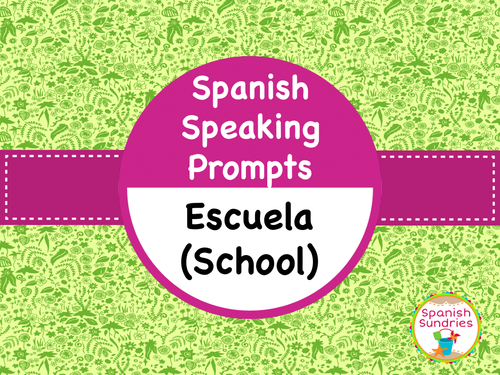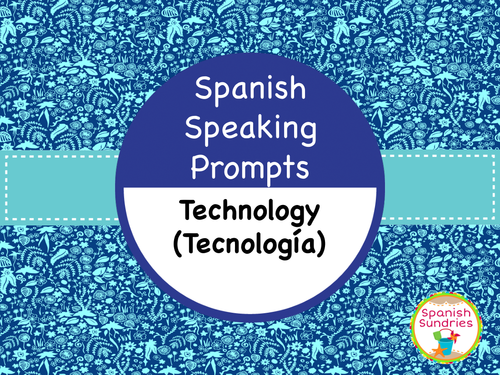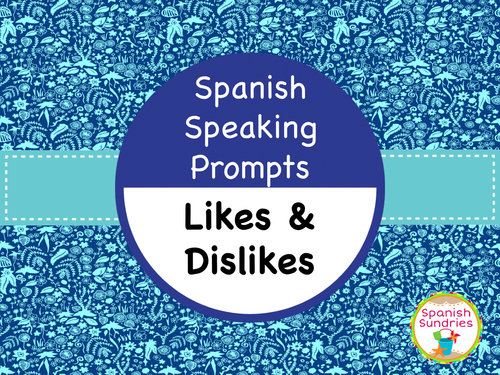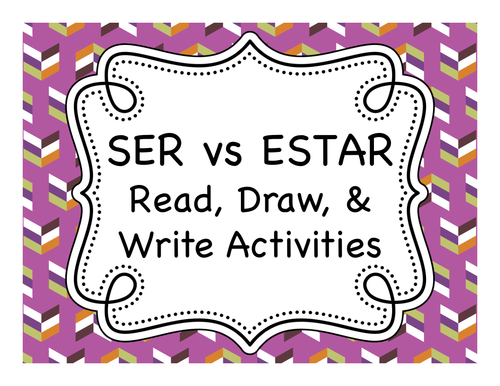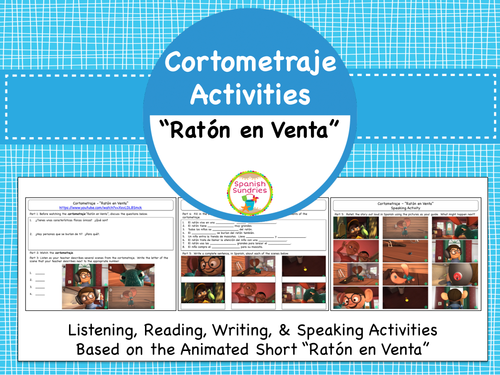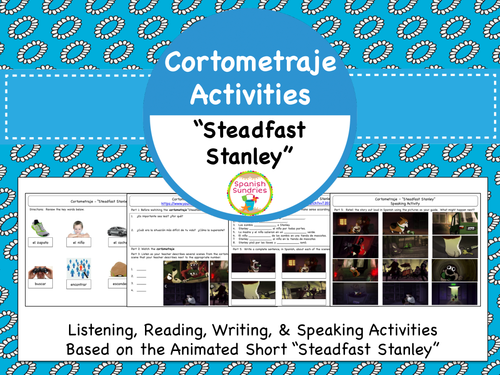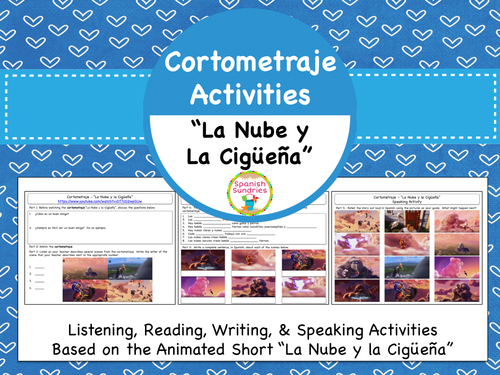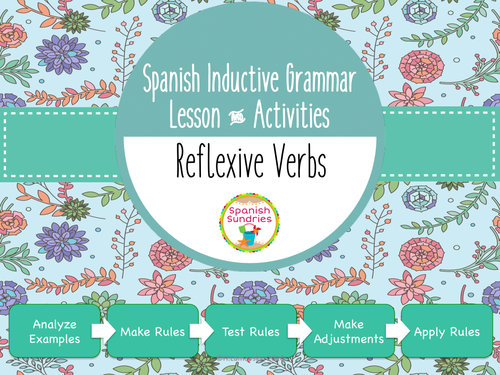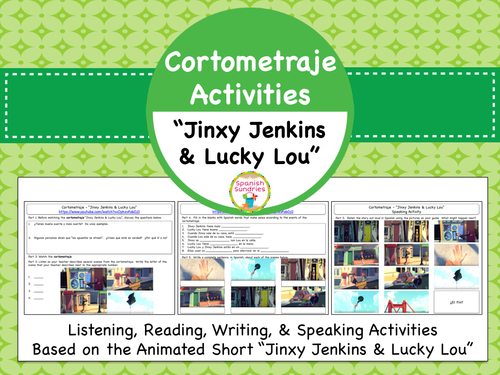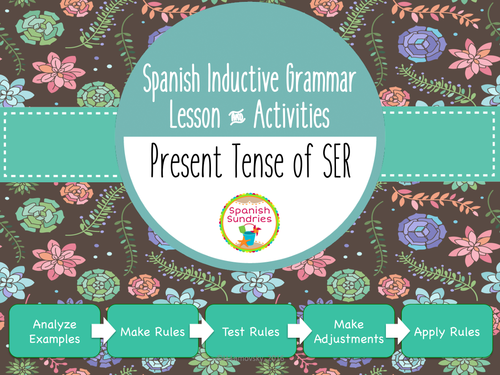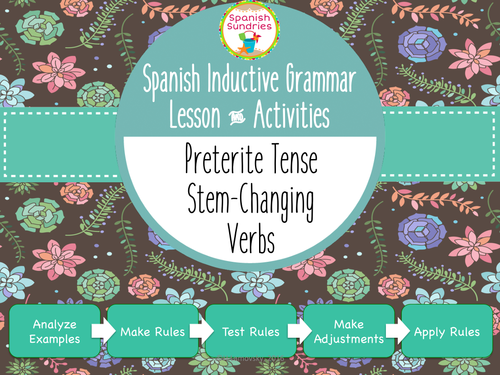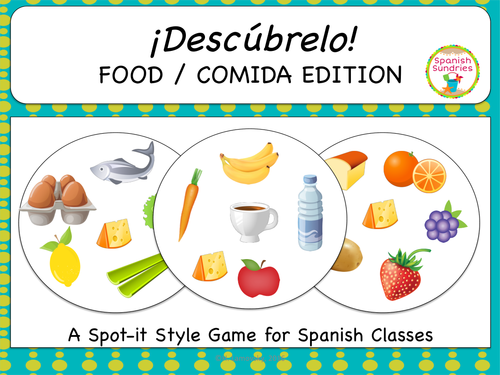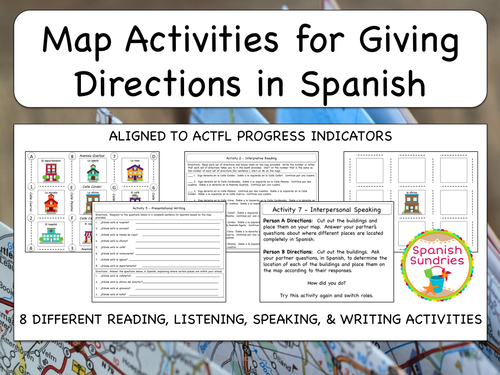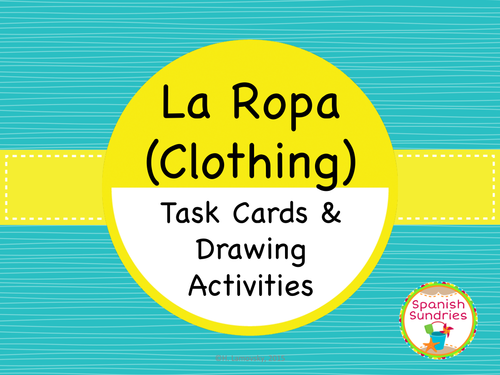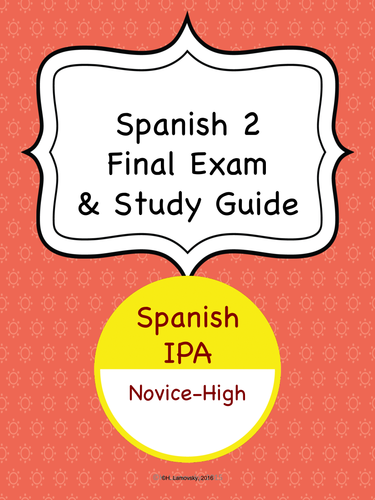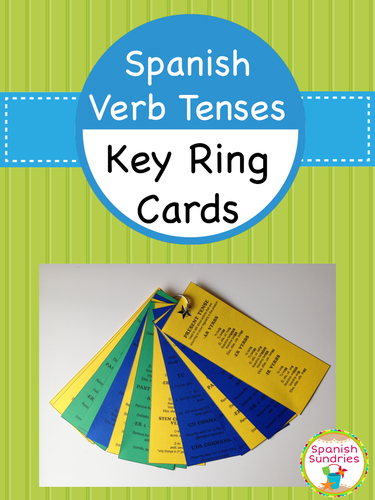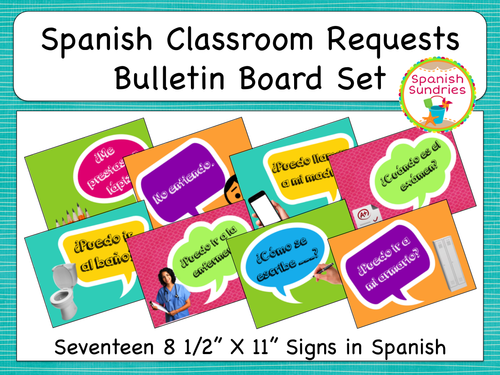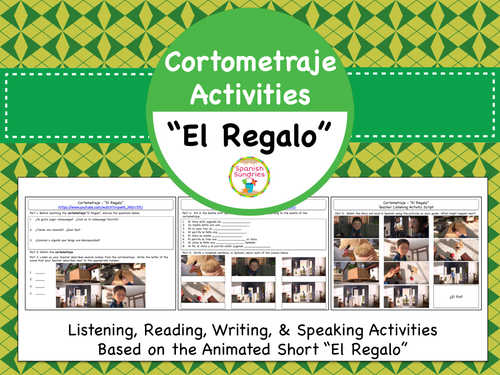
320Uploads
93k+Views
4k+Downloads
All resources

Spanish Speaking Prompts - School (Escuela)
These speaking prompts are designed to move students from asking/answering basic questions in Spanish to responding to increasingly complicated prompts around the theme of Escuela (School).
There are 4 categories of prompts that ask students to move between different levels of communication including the presentation of facts, opinions, feelings, and towards complete openness in social situations.
Category A – Yes or No Questions, Either/Or Questions
Category B – Additional Information Questions
Category C – Expressing Opinions and Feelings
Category D – Situational Speaking Prompts & Extended Response
You may approach these prompts by moving students through them from Categories A-D in a sequential manner, or you may use them as an opportunity for easy differentiation between the various proficiency levels of Novice to Intermediate learners that may be present in your classroom.
Although these prompts have been designed as speaking prompts, they can also be used as writing prompts for individual practice, homework, or assessment.
Ideas for Usage:
-Pair students for one on one practice.
-Form small groups and have students interview a student.
-Invite a guest speaker or native speaking student to your classroom and have students select questions to ask them during a Q&A session
-Have students write additional prompts or variations of existing prompts on the blank cards provided
-Pull 1 prompt from each category for a challenging oral proficiency assessment
-Have students develop role plays based on the situational prompts
This Product Includes
-Guide for Educators
-15 Category A Prompts
-15 Category B Prompts
-9 Category C Prompts
-6 Category D Prompts
-Blank Cards to allow for creation of additional questions if desired

Spanish Speaking Prompts - Tecnología
These speaking prompts are designed to move students from asking/answering basic questions in Spanish to responding to increasingly complicated prompts around the theme of Technology.
There are 4 categories of prompts that ask students to move between different levels of communication including the presentation of facts, opinions, feelings, and towards complete openness in social situations.
Category A – Yes or No Questions, Either/Or Questions
Category B – Additional Information Questions
Category C – Expressing Opinions and Feelings
Category D – Situational Speaking Prompts & Extended Response
You may approach these prompts by moving students through them from Categories A-D in a sequential manner, or you may use them as an opportunity for easy differentiation between the various proficiency levels of Novice to Intermediate learners that may be present in your classroom.
Although these prompts have been designed as speaking prompts, they can also be used as writing prompts for individual practice, homework, or assessment.
Ideas for Usage:
-Pair students for one on one practice.
-Form small groups and have students interview a student.
-Invite a guest speaker or native speaking student to your classroom and have students select questions to ask them during a Q&A session
-Have students write additional prompts or variations of existing prompts on the blank cards provided
-Pull 1 prompt from each category for a challenging oral proficiency assessment
-Have students develop role plays based on the situational prompts
This Product Includes
-Guide for Educators
-15 Category A Prompts
-15 Category B Prompts
-9 Category C Prompts
-6 Category D Prompts
-Blank Cards to allow for creation of additional questions if desired

Spanish Speaking Prompts - Likes & Dislikes
These speaking prompts are designed to move students from asking/answering basic questions in Spanish to responding to increasingly complicated prompts around the theme of Likes, Dislikes, and Preferences.
There are 4 categories of prompts that ask students to move between different levels of communication including the presentation of facts, opinions, feelings, and towards complete openness in social situations.
Category A – Yes or No Questions, Either/Or Questions
Category B – Additional Information Questions
Category C – Expressing Opinions and Feelings
Category D – Situational Speaking Prompts & Extended Response
You may approach these prompts by moving students through them from Categories A-D in a sequential manner, or you may use them as an opportunity for easy differentiation between the various proficiency levels of Novice to Intermediate learners that may be present in your classroom.
Although these prompts have been designed as speaking prompts, they can also be used as writing prompts for individual practice, homework, or assessment.
Ideas for Usage:
-Pair students for one on one practice.
-Form small groups and have students interview a student.
-Invite a guest speaker or native speaking student to your classroom and have students select questions to ask them during a Q&A session
-Have students write additional prompts or variations of existing prompts on the blank cards provided
-Pull 1 prompt from each category for a challenging oral proficiency assessment
-Have students develop role plays based on the situational prompts
This Product Includes
-Guide for Educators
-15 Category A Prompts
-15 Category B Prompts
-9 Category C Prompts
-6 Category D Prompts
-Blank Cards to allow for creation of additional questions if desired

Ser vs Estar Read, Draw & Write Activities
This sequential 4 activity sets focuses on introducing students to the difference in usage between the Spanish verbs SER and ESTAR (to be).
This product includes the following activities;
1. Concept Attainment Activity - students cut and paste Spanish sentences onto cards explaining the different reasons for the usage of SER and ESTAR.
2. Read, Conjugate, Draw Activity - Students fill in blank sentences with correct forms of the verbs SER & ESTAR, then illustrate the meaning of each sentence to demonstrate comprehension.
3. Side-by-Side Writing Prompt - Students will read a brief story in Spanish about a boy named Pablo who has an evil twin (weird, I know, but they love this stuff). Using the original story as a model, they will change the information to talk about the evil twin and invent his character in Spanish.
4. Open-Ended Writing Prompts - This activity uses two visual images for support as students apply the knowledge they have gained to write their own paragraphs using the verbs SER and ESTAR appropriately.

Cortometraje Activities: Ratón en Venta
These listening, reading, writing, and speaking activities accompany the cortometraje "Ratón en Venta". Similar to MovieTalk, these lessons focus not only on speaking, but on all communicative skills.
Students are introduced to 8 key vocabulary words that will help them to talk about the story in Spanish.
Prior to watching the animated short, they will consider a couple of questions which can then be discussed with a partner, as a whole class, or reflected on with a written response.
After watching the cortometraje, students will engage in listening activities where they must match scenes of the short with description in Spanish, reading activities where they must apply new vocabulary, writing activities where they must describe scenes, and speaking activities where they must retell the events of the story.
These are great anytime activities with a lot of comprehensible input that seek to develop all modes of communication.
This resource includes:
-Link to the Cortometraje
-Key Vocabulary
-Discussion Activity
-Listening Activity
-Listening Script for Teacher
-Reading Activity
-Writing Activity
-Speaking Activity
-Answer Keys for all Objective Activities

Cortometraje Activities: Steadfast Stanley
These listening, reading, writing, and speaking activities accompany the cortometraje "Steadfast Stanley". Similar to MovieTalk, these lessons focus not only on speaking, but on all communicative skills.
Students are introduced to 8 key vocabulary words that will help them to talk about the story in Spanish.
Prior to watching the animated short, they will consider a couple of questions which can then be discussed with a partner, as a whole class, or reflected on with a written response.
After watching the cortometraje, students will engage in listening activities where they must match scenes of the short with description in Spanish, reading activities where they must apply new vocabulary, writing activities where they must describe scenes, and speaking activities where they must retell the events of the story.
These are great anytime activities with a lot of comprehensible input that seek to develop all modes of communication.
This resource includes:
-Link to the Cortometraje
-Key Vocabulary
-Discussion Activity
-Listening Activity
-Listening Script for Teacher
-Reading Activity
-Writing Activity
-Speaking Activity
-Answer Keys for all Objective Activities

Cortometraje Activities: La Nube y la Cigüeña
These listening, reading, writing, and speaking activities accompany the cortometraje "La Nube y la Cigüeña".Similar to MovieTalk, these lessons focus not only on speaking, but on all communicative skills.
Students are introduced to 8 key vocabulary words that will help them to talk about the story in Spanish.
Prior to watching the animated short, they will consider a couple of questions which can then be discussed with a partner, as a whole class, or reflected on with a written response.
After watching the cortometraje, students will engage in listening activities where they must match scenes of the short with description in Spanish, reading activities where they must apply new vocabulary, writing activities where they must describe scenes, and speaking activities where they must retell the events of the story.
These are great anytime activities with a lot of comprehensible input that seek to develop all modes of communication.
This resource includes:
-Link to the Cortometraje
-Key Vocabulary
-Discussion Activity
-Listening Activity
-Listening Script for Teacher
-Reading Activity
-Writing Activity
-Speaking Activity
-Answer Keys for all Objective Activities

Spanish Inductive Grammar Lesson: Reflexive Verbs
This inductive grammar lesson leads students to discover the rules behind using reflexive verbs in Spanish.
Students will follow a 4 step inductive process to make learning grammar more meaningful.
Step 1: Students will see examples of correct usage and create rules based on what they observe.
Step 2: Students will test those rules against additional examples of correct language usage.
Step 3: Students will make adjustments and additions to their rules based on more observations.
Step 4: Students will apply the rules while producing their own language.
These scaffolded activities promote higher order thinking skills and represent the method of grammar instruction that is recommended by national organizations like ACTFL.

Cortometraje Activities: Jinxy Jenkins & Lucky Lou
These listening, reading, writing, and speaking activities accompany the cortometraje "Jinxy Jenkins & Lucky Lou" (link included). Similar to MovieTalk, these lessons focus not only on speaking, but on all communicative skills.
Students are introduced to 8 key vocabulary words that will help them to talk about the story in Spanish.
Prior to watching the animated short, they will consider a couple of questions which can then be discussed with a partner, as a whole class, or reflected on with a written response.
After watching the cortometraje, students will engage in listening activities where they must match scenes of the short with description in Spanish, reading activities where they must apply new vocabulary, writing activities where they must describe scenes, and speaking activities where they must retell the events of the story.
These are great anytime activities with a lot of comprehensible input that seek to develop all modes of communication.
This resource includes:
-Link to the Cortometraje
-Key Vocabulary
-Discussion Activity
-Listening Activity
-Listening Script for Teacher
-Reading Activity
-Writing Activity
-Speaking Activity
-Answer Keys for all Objective Activities

Spanish Inductive Grammar Lesson: Present Tense of Ser
This inductive grammar lesson leads students to discover the rules behind using the verb SER in the present tense in Spanish.
Students will follow a 4 step inductive process to make learning grammar more meaningful.
Step 1: Students will see examples of correct usage and create rules based on what they observe.
Step 2: Students will test those rules against additional examples of correct language usage.
Step 3: Students will make adjustments and additions to their rules based on more observations.
Step 4: Students will apply the rules while producing their own language.
These scaffolded activities promote higher order thinking skills and represent the method of grammar instruction that is recommended by national organizations like ACTFL.

Spanish Inductive Grammar Lesson: Preterite Tense Stem-Changing Verbs
This inductive grammar lesson leads students to discover the rules behind using the stem-changing verbs SERVIR and DORMIR in the preterite tense in Spanish.
Students will follow a 4 step inductive process to make learning grammar more meaningful.
Step 1: Students will see examples of correct usage and create rules based on what they observe.
Step 2: Students will test those rules against additional examples of correct language usage.
Step 3: Students will make adjustments and additions to their rules based on more observations.
Step 4: Students will apply the rules while producing their own language.
These scaffolded activities promote higher order thinking skills and represent the method of grammar instruction that is recommended by national organizations like ACTFL.

¡Descúbrelo! - Food / Comida Edition
Descúbrelo! is a Spot-it style game for use in Spanish or other world language or ESL classrooms. This edition focuses on vocabulary related to common fruits, vegetables, beverages, and other foods (comida). Since this game is picture-based, no modification is required to use it in classes teaching other second languages.
This game will help students review 30 different words related to food in the target language. It encourages use of the target language and reinforcement of vocabulary in a fun and active way.
Instructions are included for 5 varieties of game play so that you can choose what will work best depending on the number of students you are working with.
All images are in color but the game can still be played regardless of whether the cards are printed in color or black/white.
This Product Includes:
-Teacher Tips & Instructions
-Detailed Game Play Instructions (5 different games)
-31 playing cards

Giving Directions in Spanish Unit
The activities included in this unit will help students to both understand and give driving directions in Spanish. Also included are several activities to teach or review describing the location of a place using directional phrases.
Following this unit, students should be able to meet the following ACTFL progress indicators for Novice-High learners:
-Ask for directions to a place
-Tell someone how to get from one place to another
-Tell someone where something is located
-Give simple directions to a nearby location
-Understand if someone is asking for directions
This unit includes recommended vocabulary as well as 8 different activities centered around the included town maps. The activities focus on all modes of communication including interpretive listening/reading, presentational writing/speaking, and interpersonal speaking. Many of the activities are hands on and allow students to manipulate visuals as they learn. The materials included can be used in a variety of ways throughout many levels of Spanish coursework.
This product includes:
-Guide for Educators
-Vocabulary List
-2 Maps
-Map Cards
-2 Reading Activities
-2 Listening Activities
-2 Writing Activities
-2 Speaking Activities
-Answer Keys for all Objective Activities
-2 Interactive Power Point Activities

Spanish Clothing (Ropa) Task Cards & Drawing Activities
This set of activities will help your students learn to understand descriptions of clothing and learn to talk about what they and others are wearing. These activities serve as a basis for practicing clothing through listening, reading, speaking, and writing modes of communication.
Students will begin by using the included charts to flip a coin to determine the clothing items that the included paper doll will wear.
They will then use the included task cards to practice successfully identifying people with the articles of clothing described. A guide for educators is also included that gives ideas as to how to use these same drawings for simple, no prep activities, that cover all modes of communication.
This product includes:
-Guide for Educators with lesson ideas
-Flip a Coin Drawing Charts (two versions)
-Fabio Paper Doll Template
-30 Task Cards
-Task Card Response Sheet

Spanish 2 Final Exam & Study Guide
This final exam is meant for second year proficiency-based classrooms. It also easily adapted as a mid-year exam for a level 3 course. The exam aligns directly with the ACTFL progress indicators Novice-High language learners.
Interpretive Listening, Reading, Culture, and Presentational writing are all addressed by the exam. You may choose to assess all modes of communication or use only particular sections of the exam depending on the turnaround time you have with grading them.
You will also find a study guide that may be handed out to students to help them prepare for the exam.
Also included are links to listening samples, scripts, rubrics, forms, and other information that will be helpful in administering the exam.
This exam addresses the following themes:
-House
-Driving Directions
-Weather
-Clothing
-Food
This product includes the following:
-Guide for Educators
-Student Study Guide
-Links to listening samples, rubrics, etc
-Listening Section (20 MC questions)
-Reading Section (20 MC questions)
-Writing Section (5 prompts)
-Answer Key for all Objective sections

Spanish Verb Tense Key Ring Cards
These handy key ring cards provide the most important information about each Spanish verb tense. These are a great tool to have available as students begin to write independently.
Each card is double-sided and features the name of the tense, the uses of the tense, as well as instructions and examples of the formations of both regular and irregular verbs.
The following cards are included in this resource:
-Present Tense
-Present Progressive Tense
-Present Perfect Tense
-Preterite Tense
-Imperfect Tense
-Imperfect Progressive Tense
-Past Perfect Tense
-Future Tense
-Future Perfect Tense
-Conditional Tense
-Affirmative Commands (all types)
-Negative Commands (all types)
-Present Subjunctive
-Imperfect Subjunctive

Spanish Classroom Requests Bulletin Board Set
This resource contains seventeen 8 1/2" x 11" signs based on common classroom requests and situations. They can be used as a bulletin board set, word wall, or displayed anywhere in your classroom.
These signs contain many of the expressions that your students will need to operate in the target language from Day 1. Even beginning level classes can learn to make requests quickly and easily with these signs serving as a reference.
Each sign has a phrase or question, in Spanish, as well as a visual to help students remember the meaning.
Included Phrases & Questions:
-¿Puedo ir al baño?
-¿Puedo tomar agua?
-¿Puedo ir a mi armario?
-Necesito ir a la oficina
-¿Me prestas un lápiz?
-¿Puedo ir a la enfermera?
-¿Puedo llamar a mi madre?
-¿Cómo se dice _____?
-¿Qué significa _____?
-Repita, por favor.
-¿Tienes una hoja de papel?
-¿Cuándo es el exámen?
-¿Puedo escuchar la música?
-¿Cómo se escribe _____?
-No entiendo
-Explique de nuevo, por favor.
-¿En qué página estámos?

Cortometraje Activities: El Regalo
These listening, reading, writing, and speaking activities accompany the cortometraje (short) "El Regalo" (link included).
Students are introduced to 8 key vocabulary words that will help them to talk about the story in Spanish.
Prior to watching the animated short, they will consider a couple of questions which can then be discussed with a partner, as a whole class, or reflected on with a written response.
After watching the cortometraje, students will engage in listening activities where they must match scenes of the short with description in Spanish, reading activities where they must apply new vocabulary, writing activities where they must describe scenes, and speaking activities where they must retell the events of the story.
These are great anytime activities with a lot of comprehensible input that seek to develop all modes of communication.
This resource includes:
-Link to the Cortometraje
-Key Vocabulary
-Discussion Activity
-Listening Activity
-Listening Script for Teacher
-Reading Activity
-Writing Activity
-Speaking Activity
-Answer Keys for all Objective Activities

Cortometraje Activities: El Puente
These listening, reading, writing, and speaking activities accompany the cortometraje (short) "El Puente" (link included).
Students are introduced to 8 key vocabulary words that will help them to talk about the story in Spanish.
Prior to watching the animated short, they will consider a couple of questions which can then be discussed with a partner, as a whole class, or reflected on with a written response.
After watching the cortometraje, students will engage in listening activities where they must match scenes of the short with description in Spanish, reading activities where they must apply new vocabulary, writing activities where they must describe scenes, and speaking activities where they must retell the events of the story.
These are great anytime activities with a lot of comprehensible input that seek to develop all modes of communication.
This resource includes:
-Link to the Cortometraje
-Key Vocabulary
-Discussion Activity
-Listening Activity
-Listening Script for Teacher
-Reading Activity
-Writing Activity
-Speaking Activity
-Answer Keys for all Objective Activities

Cortometraje Activities: Selfie Cat
These listening, reading, writing, and speaking activities accompany the cortometraje "Selfie Cat". Similar to MovieTalk, these lessons focus not only on speaking, but on all communicative skills.
Students are introduced to 8 key vocabulary words that will help them to talk about the story in Spanish.
Prior to watching the animated short, they will consider a couple of questions which can then be discussed with a partner, as a whole class, or reflected on with a written response.
After watching the cortometraje, students will engage in listening activities where they must match scenes of the short with description in Spanish, reading activities where they must apply new vocabulary, writing activities where they must describe scenes, and speaking activities where they must retell the events of the story.
These are great anytime activities with a lot of comprehensible input that seek to develop all modes of communication.
This resource includes:
-Link to the Cortometraje
-Key Vocabulary
-Discussion Activity
-Listening Activity
-Listening Script for Teacher
-Reading Activity
-Writing Activity
-Speaking Activity
-Answer Keys for all Objective Activities

